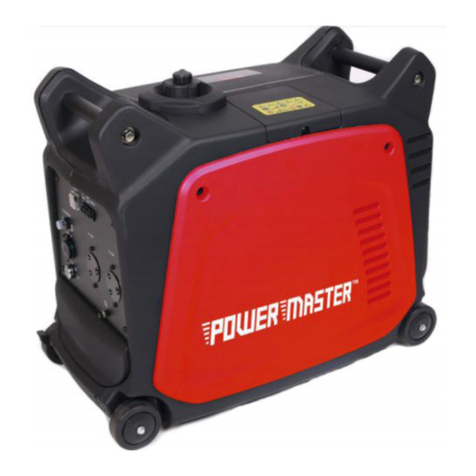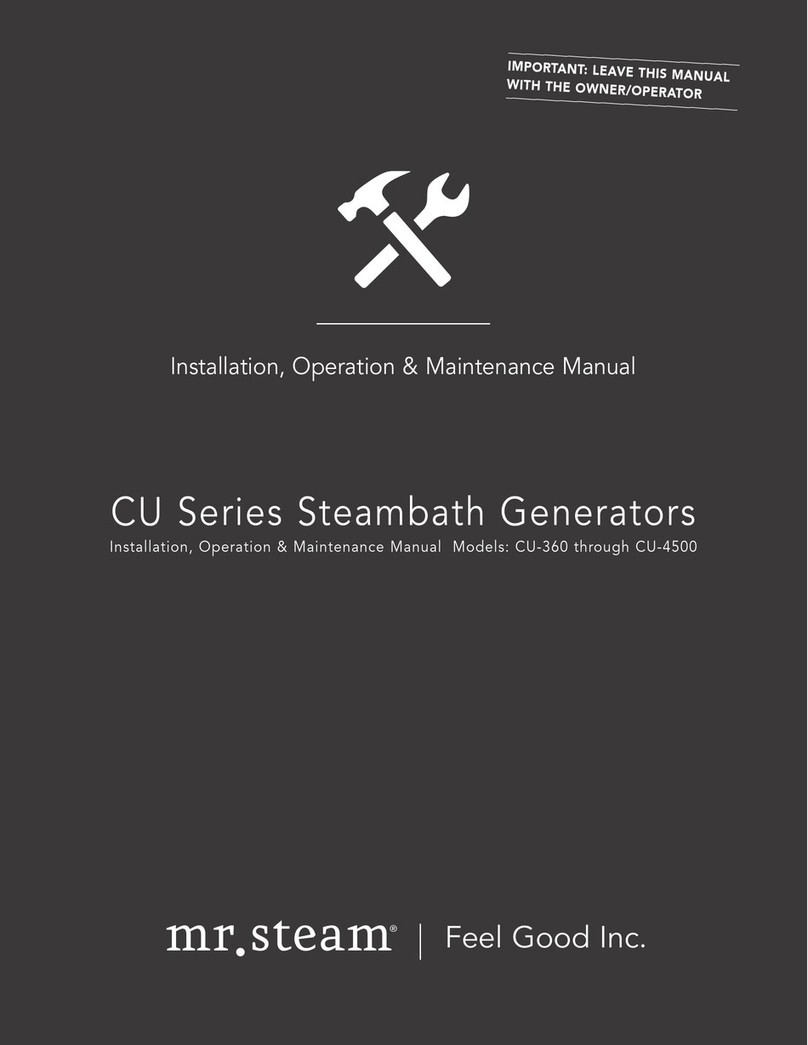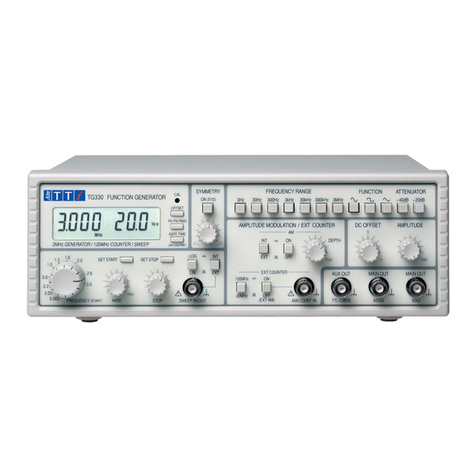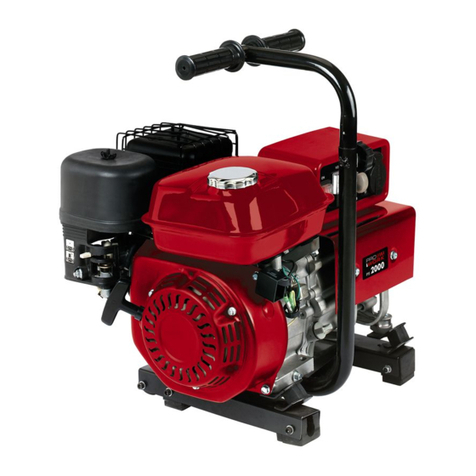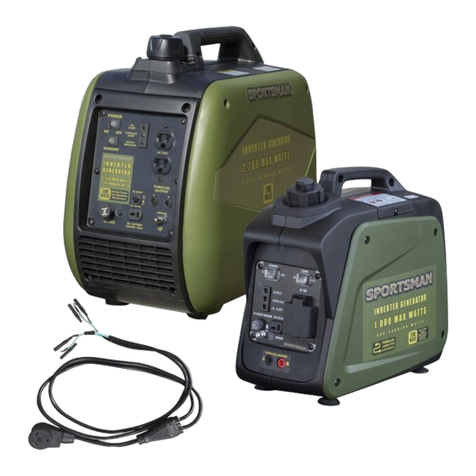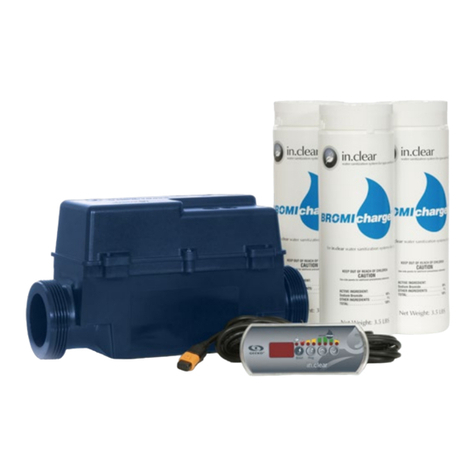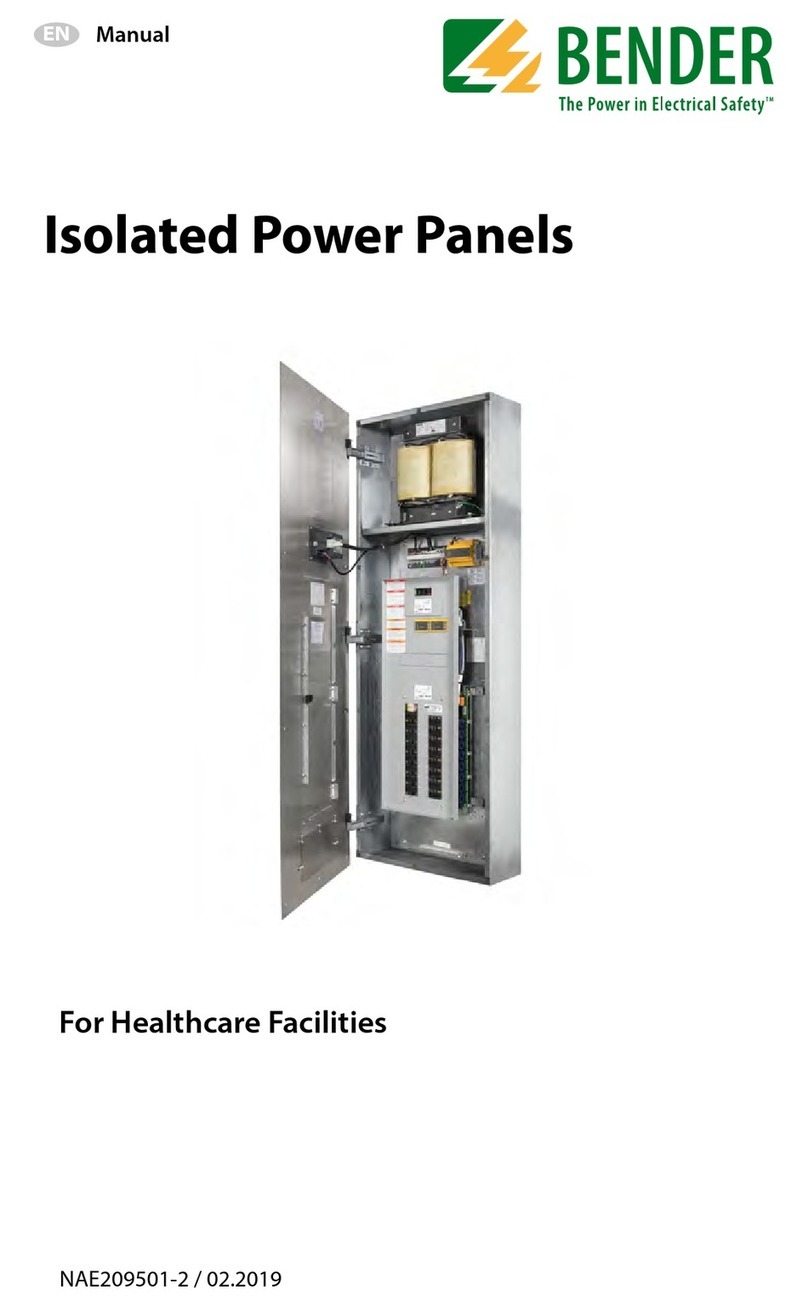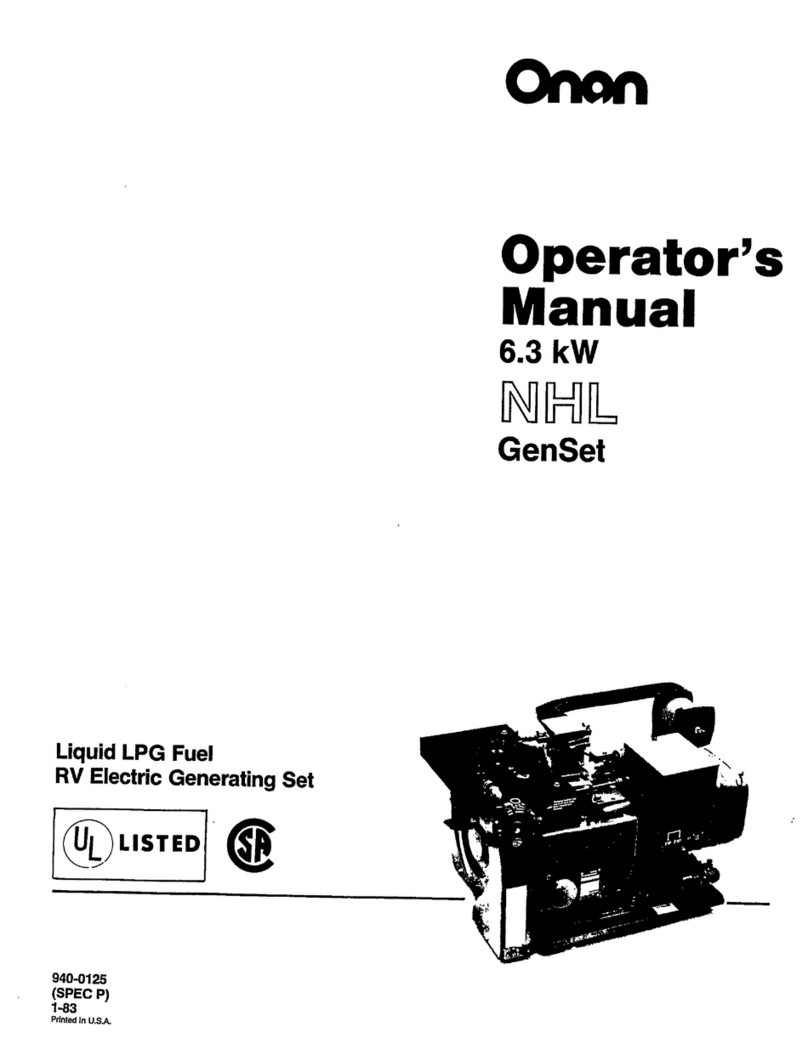Gentech GP8000IS User manual

POWER WHEN YOU NEED IT
TO KEEP YOUR GENERATOR LASTING
LONGER REMEMBER TO SERVICE IT!
Generator Operators Manual GP8000IS
11 HRS @ 50% LOAD
6 HRS @ 100% LOAD
8000
MAXIMUM RATED OUTPUT
W
Now Supplied
with Gentech
Engine Oil
SAE 15W-40 Engine Oil
1000ml
1000ml
SAE
15W-40 Engine Oil
YEAR
WARRANTY
1
RECOIL / ELECTRIC
STARTING METHOD


•
DANGER
This indicates a hazardous situation, which, if not avoided, will result in death or serious
injury.
•
WARNING:
This indicates a hazardous situation, which, if not avoided, could result in death or serious
injury.
•
CAUTION:
This indicates a hazardous situation, which, if not avoided, could result in injury.
DANGER
WARNING
CAUTION
IMPORTANT:
Thank you for purchasing a Gentech Gasoline Generating Set (hereinafter referred to as the
"generator").
This manual will assist you in operating and maintaining your generator. This manual is the latest
version. With the continuous improvement and upgrading of this product, the manufacturer reserves the
right to modify this manual without notice. The manufacturer shall assume no liability for incorrect
information contained in this manual.
This manual is an integral part of the generator. When the generator is transferred to others, this
manual should be handed over to the new owner.
Some important information in this manual will be indicated in the following way, please see below). The
users should pay special attention to these instructions.
The range of GENTECH GENERATORS POWERED BY HONDA is safe and reliable, but incorrect use
of these products may cause personal injury and or damage to your machine. Please read this manual
thoroughly before operation as this product is required to operate strictly in accordance with this
manual.
IMPORTANT:
PLEASE PAY SPECIAL ATTENTION TO STATEMENTS PRECEDED BY THE FOLLOWING
WORDS:

1
DANGER WARNING CAUTION
GENERAL SAFETY PRECAUTIONS:
A “LAYMAN" and or "CHILDREN" may
not recognize the possible dangers of
operating a generator. We recommend that
only competent persons should operate the
generator.
Fuel is combustible and easily ignited. Do
not refuel during operation.
Do not refuel whilst smoking or near naked
flames. Do not overfill or spill fuel. If this
happens clean the fuel on and around the
generator properly before operating.
Only use the specified fuel when operating
the generator
Some parts of the internal-combustion
engine are hot and might cause burns. Pay
attention to the warning signs on the
generating set.
Engine exhaust gases are toxic. Do not
operate the generator in an unventilated
room. When installed in a ventilated room,
additional requirements for fire and
explosion protection must be observed.
Regularly check that the bolts and nuts are
properly tightened as they may become lose
due to vibration of the generator whilst in
use.
Before using the generator ensure that you
have checked the periodic maintenance
schedule in the operator's manual.
Pay attention to the wiring or extension
cords from the generator to the connected
device. If the wire is under the generator or
in contact with a vibrating part, it may break
and possibly cause a fire, generator burnout,
or electric shock hazard. Replace damaged
or worn cords immediately.
Do not operate in rain wet or damp
conditions, or with wet hands. The operator
may suffer severe electric shock if the
generator is wet.
1.1.
1.2.
1.3.
1.4.
1.5.
1.6.
1.7.
1.8.
1.9.
1.10.
1.
1.11.
1.12.
1.13.
1.14.
1.15.
1.16.
1.17.
1.18.
If wet, wipe and dry it well before starting.
Do not pour water directly over the
generator, nor was hit with water.
Be extremely careful that all necessary
electrical grounding procedures are followed
during each and every use. Failure to do so
can be fatal.
Do not connect the generator to commercial
power line. Connecting to a commercial
power line may short circuit the generator.
We strongly recommend the use of a
Transfer Switch for connecting to a domestic
circuit.
Do not smoke when handling the battery.
The battery emits flammable hydrogen gas,
which can explode if exposed to cigarettes
and or naked flames. Keep the area well-
ventilated and keep naked flames/ sparks
away when handling the battery.
Keep children and all bystanders at a safe
distance from the generator whilst in use.
It is essential that you know and understand
the safe and proper use of the power tool or
appliance that you intend to connect to the
generator. All operators must read,
understand, and follow the tool/ appliance
operator's manual. The tool and appliance
applications and limitations must be
understood. Keep all instruction manuals
and in a safe place for future reference.
Always switch off the circuit breaker on the
generator when not in use.
Do note store the generator inside a house
or office. Do not store the generator where it
will be exposed to rain or water.

2
ELECTRICAL SAFETY INFORMATION:
Electrical equipment including cable, cords and plug connection must not be defective. Please check
before using.
Do not plug the generator directly into a wall socket-outlet.
The generator should not be connected to other sources such as the power company supply mains.
In special cases where stand-by connection to existing electrical systems or integration therewith is
intended, note that it is a legal requirement that such connections. or integration may only be
performed by a competent person.
Protection against electrical shock depends on circuit-breakers that are specially matched to the
generator. If a circuit breaker requires replacement, it shall be replaced by a circuit breaker that has
identical ratings and performance characteristics.
Due to high mechanical stresses only tough rubber-sheathed flexible cable should be used.
If the generator is of CLASS II construction, then earthing of the generator is not required.
Cord Extension Sets:
A 1.0 mm² flexible cable can draw a maximum of 10 A provided that the cable is no longer than 25 m.
A 1.5 mm² flexible cable can draw a maximum of 10 A provided that the cable is no longer than 35 m.
A 1.5 mm² flexible cable can draw a maximum of 16 A provided that the cable is no longer than 20 m.
A 2.5 mm² flexible cable can draw a maximum of 10 A provided the cable is no longer than 65 m.
A 2.5 mm² flexible cable can draw a maximum of 16 A provided that the cable is no longer than 45 m.
A 4 mm² flexible cable can draw a maximum of 10 A provided that the cable is no longer than 100 m.
A4 mm² flexible cable can draw a maximum of 16 A provided that the cable is no longer than 65 m.
DROP IN ELECTRIC EXTENSION CORDS:
When a long electric extension cord is used to connect an appliance or tool to the generator, a
certain amount of voltage drops or loss occurs in the extension cord which reduces the effective
voltage available for the appliance or tool.
The chart below has been prepared to illustrate the approximate voltage loss when an extension
cord of 300 feet (approx.100 meters) is used to connect an appliance or tool to the generator.
2.
2.1.
2.2.
2.3.
2.4.
2.5.
2.6.
2.7.
2.7.1
2.7.2.
2.7.3.
2.7.4.
2.7.5.
2.7.6.
2.7.7.
2.8.

3
SAFETY STICKERS AND EXPLANATIONS:
3.

4
Specifications are subject to change without notice.
SPECIFICATIONS:4.

5
(1) FRAME
(2) FUEL TANK
(3) CONTROL PANEL
(4) TROLLEY WHEEL
(5) RIGHT MAINTENANCE COVER
(6) HANDLE
(1) FUEL TANK CAP
(2) HANDLE
(3) MUFFLER
(4) WHEEL LOCK
(5) RECOIL STARTER
COMPONENTS:
5.
2
4
5
3

6
WARNING
6.
6.1.
6.1.1.
6.1.2.
6.1.3.
6.1.4.
6.2.
6.2.1.
6.3.
6.3.1.
6.4.1
6.4.2.
6.4.3.
6.4.
PRE-OPERATION CHECKS:
CHECKING THE ENGINE OIL
Ensure that the generator is on a flat and level surface before
adding oil.
Remove the oil cap and check the level of the oil.
Add oil to the generator if the oil is below the indicator line.
Always ensure that your engine oil is clean.
OIL CAPACITY FOR THE GP8000IS GENERATOR:
GP8000IS - 1.0L
RECOMMENDED ENGINE OIL:
Only use 4-stroke automotive oil (API or SE) alternatively you can use a higher grade (SG, SH or
SJ). is recommended for general all-temperature use. For extreme temperatures SAE 15W-40
please use . If single viscosity oil is used, select the appropriate viscosity for the SAE 10W-50
average temperature in your area.
Use the fuel gauge to check the fuel level.
If the fuel level is too low, only refuel with unleaded fuel.
Ensure that you use the fuel filter screen on the fuel filter.
CHECKING THE ENGINE FUEL:
Do not refuel while smoking or near an open flame or other potential fire hazards.
Left
Maintenance
Cover

7
6.5.
6.5.1
FUEL CAPACITY FOR THE GP8000IS GENERATOR:
LEAD ACID BATTERY OPERATION FOR THE GP8000IS:
Installation:
ŸCheck the battery voltage with a voltmeter before fitting. If the voltage is less than
12.8 Volts, do a refresh charge (see charging section).
The recommended battery capacity is a 14 Amp Hour.
GP8000IS - 26L
Make sure you review each warning in order to prevent fire hazards. Do not refill the fuel tank
whilst the engine is running or hot. Please ensure that the fuel cock is closed before refueling.
Be careful not to contaminate the fuel with any dust, dirt, water, or other foreign liquids/objects.
Please lean all spilt fuel thoroughly before starting the generator. Ensure that the generator is
clear from any open flames. Do not smoke whist refueling the generator.
CHECKING COMPONENT PARTS:
Before starting the generator, please check the following:
Check for any fuel leaking from any part of the generator.
Check that all the nuts and bolts are securely tightened on the generator.
Check for any visible damaged components on the generator.
Check that the generator is not resting on or adjacent to any electrical wiring.
CHECK THE GENERATOR SURROUNDINGS:
6.6.
6.7.
6.8.
6.6.2.
6.6.3.
6.6.4.
6.6.5.
WARNING
Make sure you review each warning in order to prevent fire hazards. Keep the surrounding
area clear of flammables or other hazardous materials. Keep the generator at least 3 feet
(1 meter) away from all buildings and or other structures. Only operate the generator in a dry,
well-ventilated area. Keep the exhaust pipe clear of all foreign objects. Keep the generator
away from open flames. Do not smoke near the generator. Keep the generator on a flat and
level surface. Do not attempt to block the generator air vents with any paper or other
material/objects
Health Warning:
The electrolyte inside the battery is harmful to skin and eyes. If the battery leaks and the
electrolyte get into your eyes, do not rub them. Instead, rinse them with clean running water
and immediately seek medical attention. If left untreated, electrolyte can cause permanent
injury to your eyes.

8
Installation:
ŸCheck the battery voltage with a voltmeter before fitting. If the voltage
is less than
ŸA12.8 Volts, do a refresh charge (see charging section).
ŸAlways follow the manufacturer's instruction guidelines when
connecting the battery.
ŸConnect the positive and negative leads correctly.
ŸFit the battery with spacer when needed for best possible fit.
Charging:
ŸBoth the generator and battery charger need to limit the voltage
between 14.0 - 15.0 Volts when charging. The battery cannot be fully
charged if charging voltage is less than 14.0 Volts, and the battery
would be damaged if the charging voltage is over 15.0 Volts.
ŸThe battery must be charged using the standard current specified in
charging label if the voltage is less than 8 Volts.
ŸAlways remove the battery from the generator before charging
separately.
ŸCharge the battery with a lower current rather than the MAX Charging
Current found on the Charging label.
ŸAfter charging, leave the battery for approximately 1 to 2 hours before
checking the voltage. If the voltage is less than 12.8 Volts, additional
charging is required.
ŸIf the battery becomes too hot to touch, stop charging. Allow battery to
cool before resuming.
Storage:
ŸThe battery should be stored with approximately 70% charge state.
ŸThe battery should be stored in clean, dry and ventilated environment (-20-40 Degrees Celsius),
not in contact with any corrosive substance and away from heat and fire.
ŸThe battery should be charged completely once every 180 days when in storage.
Transportation:
ŸThe battery should be transported with approximately 70% charge state.
ŸThe battery should be packed with insulation and shockproof material to avoid damage from
sudden jolts and collision.
ŸThe battery should be handled with care when loading and unloading during transport. Do not
throw the batteries and avoid collision.
ŸDo not transport the batteries together with flammable, explosive objects, or sharp metal goods.
Maintenance:
ŸDisconnection of the battery cable is always the best choice if the generator is in storage or used
infrequently. Use a standard charger to maintain the battery.
ŸIf the battery stands by for any period, check the voltage in case the voltage is lower than 12.8
Volts, and recharge according to the charging label.
ŸKeep the connecting poles clean and securely fastened.
ŸThe battery is factory sealed and requires no topping up of any fluid. Never attempt to open the
battery.
1. Do not immerse the battery in water.
2. Do not use or store the battery near sources of fire or heat.
3. Do not reverse the positive (+) or negative (-) terminals.
4. Do not connect the battery directly to wall outlets.
5. Do not put the battery into a fire or apply direct heat to it.
6. Do not short-circuit the battery by connecting wires or other metal objects to the positive(+) and
negative(-) terminals.
7. Do not pierce the battery casing with a nail or other sharp objects, break it open with a hammer, or
step on it.
8. Do not strike, throw, or subject the battery to sever physical shock.
9. Do not directly solder the battery terminals.
10. Do not attempt to disassemble or modify the battery in any way.

9
11. Do not place the battery in a microwave oven or pressurized container.
12. Do not use the battery in combination with primary batteries (such as dry cell batteries) or
batteries of different capacity, type, or brand.
13. Do not use the battery if it gives off an odor, generates heat, becomes discolored or deformed,
or appears abnormal in any way. If the battery is in use or being recharge, remove it from the
device or charger immediately and discontinue use.
14. Do not use more than one battery in parallel or in series.
15. Do not press on indicator button longer than few seconds.
16. Do not dispose the battery before completely discharge.
17. Do not charge the battery by charging voltage over 15.0V.
18. Do not charge the battery by charging with an automatic "de-sulfation mode" function.
19. The battery will fail if over charged, it may happen to deform or fume.
20. Please fix the battery terminal with original screws and nuts securely.
21. The cranking performance will be affected when environment temperature lower than.
22. Keep out of reach of Children and Pets.
GROUNDING THE GENERATOR:
When grounding the generator connect the grounding lug of the generator to the
grounding spike.
If such grounding conductor or ground electrode is unavailable, connect the grounding
lug of the generator to the grounding terminal of the electric tool or appliance.
CONTROL PANEL FOR GP8000IS:
PANEL INTRODUCTION:
6.9.
6.9.1
6.9.2
GROUNDING
SPIKE
Engine Switch.
Data Display.
Engine Start / Stop.
Low Idle.
Two Wire Control Switch.
Two Wire Control Connection.
ATS.
Circuit Breaker 9A.
DC 12V USB.
AC Receptacles 230V.
AC Receptacles 230V.
Grounding Nut.
Circuit Breaker 25A.
Main Breaker 31A.
Parallel Operation Outlets.
Fuel Switch.
(1)
(2)
(3)
(4)
(5)
(6)
(7)
(8)
(9)
(10)
(11)
(12)
(13)
(14)
(15)
(16)
1 2 3 45678 9
101114 13 1216 15
Circuit Breaker

10
OPERATING PROCEDURES:
STARTING THE GENERATOR ENGINE FOR THE GP8000IS:
*NOTE: If you are starting the generator for the first time, we recommend that you
use the recoil starter.
*NOTE: When pulling the hand starter, grasp the handle to prevent the generator
from falling down.
7.
7.1.1.
7.1.2.
7.1.3
7.1.4.
7.1.5.
7.1.6.
7.1.7.
7.1.7.
7.1.7.
A.
B.
C.
When the ambient temperature is lower than 0°C (32°F), the engine speed is 4100rpm and the
warm-up time is 3min.
When the ambient temperature is below -5°C (41°F), the engine speed is 4100rpm and the warm-up
time is 3min.
After the above operation time, the fuel saving switch can work normally in "ON" position.
WARNING
Do not move the generator while it is running.
Be sure to ground the generator if the connected appliance is grounded.
Failure to ground the unit may lead to electrical shock.
Turn the Fuel Saving switch to "OFF" position.
Turn the Air Knob on the Fuel Tank to the "On" position.
Open the Fuel Choke.
Turn the Combined Switch to "Start" position.
Press & hold the “Start Button” for 4 seconds and wait for the
generator to start.
To manual start pull the Recoil Starter until resistance is felt.
Do not pull the rope of the recoil starter out completely.
After starting the generator allow the engine to warm up and rotate
the Combination Switch to the “Run” position.
After starting the engine successfully, press the fuel-saveing switch
in the “On” position.

11
CAUTION
8.
8.2.
8.1.1.
8.1.2.
8.1.3.
8.1.4.
8.1.5.
8.1.6.
8.1.7.
8.1.8.
8.2.1.
8.2.2.
AC APPLICATION:
Check the digital meter for sufficient voltage.
This generator is properly tested and adjusted and set at the
factory.
Should the generator does not produce the specified voltage
please contact GENTECH INDUSTRIES.
Turn off the switch (es) of the electrical appliance(s) before
connecting to the generator.
Insert the plug(s) of the electrical appliance(s) into the receptacle.
Check the amperage of the receptacles used referring to the
TABLE on page 4 and be careful not to take a current exceeding
the specified amperage.
Check that the total wattage of all appliances that is being
connected to the generator does not exceed the rated output of
the generator.
Turn on the appliance switch.
*NOTE: If the overload alarm light (red) flashes during operation, the generator is overloaded, or the
appliance is defective. Stop the generator immediately and check the appliance and /or
generator for overloading. Push engine button or "reset" to re-start the machine.
If a large starting current is required, such as a compressor or pump, the overload indicator
may flash for a short time, but this is not a fault.
CONNECTING TO DOMESTIC CIRCUITS (HOUSE WIRING):
WARNING
If a generator is to be connected to residential or commercial power lines for stand-by
power during power outage, all connections must be made by a competent person/ licensed
electrician. Connection failure, or improper connection, may result in death, personal injury,
damage to the generator, damage to the appliances, damage to the building's wiring, or even
result in a fire.
When connecting the generator to the house wiring the generator output power must be taken from
the 230 Volt receptacle.
A transfer switch must be installed to transfer the load from the commercial power source to the
generator. This switch is necessary to prevent accidents caused by the recovery from power
outages. Use a transfer switch of the correct capacity. Install the transfer switch between the meter
and the fuse or AC Breaker Box
If the neutral wire of the house wiring is earthed, be sure to earth the ground terminal of the
generator. An electric shock may result if this procedure is not followed.

12
8.3.
8.3.1
8.3.2
8.3.3
SAFETY PRECAUTIONS WHILE CHARGING THE BATTERY:
An explosive hydrogen gas is discharged through vent holes in the battery during the charging
process.
Electrolyte fluid can burn your eyes and clothing. Be extremely careful and avoid contact. If contact
occurs wash the affected area immediately with large quantities of water or milk and consult a doctor
for treatment.
When charging a large capacity battery or totally discharging a battery excessive current may force
the DC breaker to turn off. In such cases use a battery charger to charge a large battery with an AC
output.

13
OIL SENSOR:
The oil sensor detects a drop in the oil level in the crank case and
automatically stops the engine when oil level drops below a
predetermined level.
When engine has stops automatically switch off the generator's
circuit breaker and check the oil level. Refill with engine oil to the
upper level as instructed on clause 6.1, and then restart the
engine.
If the engine does not start, please recheck the oil level.
8.4.
8.5.
8.4.1.
8.4.2.
8.4.3.
8.4.4.
8.4.5.
8.4.6.
8.5.1.
8.5.2.
8.5.3.
CAUTION
Do not remove the OIL SENSOR PROBE when refilling
with oil. Remove the oil filler cap on the opposite side of
carburetor.
STOPPING THE GENERATOR:
Turn the “Fuel Saving” switch to the “Off” position.
Turn off the power switch of the electric equipment and unplug the cord
from the receptacle of the generator.
Turn the “Combined” switch to the “Stop” position.
Allow the engine to cool down for about three minutes with no load prior to
switching it off.
After the generator has cooled down, turn the “Air Knob” on top of the
“Fuel Cap” to the “Off” position.
For recoil starter models turn the switch to the “OFF” position
For electric start models, press the button to stop the engine and turn off
the battery switch.

14
LCD Display: Press the "SELECT" button to change the LCD display from voltage, hours run,
frequency and oil level.
Hour Run/ Time Indicated on the Digital Meter: 0.1h = 6 minutes, 0.2h = 12 minutes. The meter
display will only change every 6 running minutes.
Display Frequency: 2:30 Hz (EG: 50 Hz will display as F-50)
Display Voltage:160 - 250 V Ac (EG: 230 V will display as U230)
Oil Level Display: If there is insufficient oil in the machine the oil light will flash red and the machine
will automatically switch off. Do not attempt to restart the machine until you have re filled with oil.
Digital Meter Maintenance Display Tips:
P-25: Machine requires the oil to be changed.
P-50: Machine requires the air filter element and the oil to be changed.
P-100: The machine requires the fuel filter, air filter element and the oil to be changed.
8.6.3.
8.6.4.
8.6.5.
8.6.6.
8.6.7.
8.6.8.
*NOTE: THE MAINTENANCE TIPS AS INDICATED ABOVE, ONCE DISPLAYED, WILL NOT SHOW
AGAIN AFTER THE MACHINE HAS BEEN SWITCHED OFF AND THEN RESTARTED.
*NOTE: PLEASE REFER TO THE CONSUMPTION CHART AND LOAD CALCULATOR IN THE QUICK
REFERENCE GUIDE BOOKLET.
CAUTION
DO NOT TAMPER OR OPEN THE DIGITAL METER AS IT WILL NULLIFY YOUR WARRANTY AND
MAY ALSO LEAD TO AN ELECTRIC SHOCK.
WATTAGE INFORMATION:
Some appliances need a "Surge" of energy when starting. This is commonly known as a
"LAGGING" Load.
This means that the amount of electrical power needed to start the appliance may exceed the
amount needed to maintain its use.
Electrical appliances and tools normally come with a label indicating voltage, cycles/Hz, amperage
(amps) and electrical power needed to run the appliance or tool.
Check with your nearest branch with questions regarding power surges of certain appliances or
power tools.
Electrical loads such as incandescent lamps and hot plates require the same wattage to start as is
needed to maintain their use. This is commonly known as a "LEADING" Load.
Loads such as fluorescent lamps require1.5 to 2 times the indicated wattage during start-up.
Electrical motors require a large starting current. Power requirements depend on the type of motor
and its use Once enough "Power" is attained to start the motor, the appliance will require only
+-50% of the wattage in order to continue running.
Most electrical tools require 1.5 to 3 times their wattage for running under load during use. Loads
such as submersible pumps and air compressors require a very large force to start. They need 3 to
5 times the normal running wattage in order to start.
9.
9.1.
9.2.
9.3.
9.4.
9.5.
9.6.
9.7.
9.8.

15
ELECTRICAL CONNECTING:
LOAD CAPACITY:
9.2.
9.3.
*NOTE: Before use, the generator set and its electrical equipment (including lines and plug
connections) should be checked to ensure that they are not defective.
The generator set must not be connected to other power sources, such as the power
company supply mains.
9.4.
9.5.
9.5.1.
9.5.2.
9.5.3.
9.5.4.
9.5.5.
9.5.6.
9.3.1.
9.3.2.
9.3.3.
9.4.1.
9.4.2.
9.4.4.
9.4.5.
9.4.6.
9.4.7.
9.4.8.
9.4.9.
9.4.10.
Before connecting the electrical equipment, please follow the following steps to calculate the
starting power required for the electrical equipment:
Select the electric equipment running at the same time.
The total operating power is the required power.
Calculate the maximum starting power required according to the following steps:
Calculate these numbers according to the steps required.
Fluctuation power is the extra surge power required for electric drive equipment.
Power Management
Voltage and current power are converted by the following formula: Voltage x Current = Power
In order to extend the service life of the generator set, please refer to the following steps to increase
the power load:
Start the generator set without power load.
Let the generator continue to run for a few minutes until stable.
Turn “fuel saving” switch to “ON”.
Then plug in and run the first electrical device. It is better to allow the maximum power to be
connected to the generator set first.
Wait till the generator set is stable.
Connect it to another electrical device.
Wait till the generator set is stable.
Repeat step 6 and 7 until complete; and then turn on the connected electrical equipment.
Connecting One Generator to the Electrical Appliances:
Start the generator set and keep running until it stabilizes.
Before connecting the electrical tools and equipment, determine the rated voltage of the generator
set {230V ac, 7A; 12V de, 8A) and ensure that there is enough current capacity to supply all
electrical equipment. If the power consumption exceeds the maximum power of the generator set,
connect the electrical equipment to the generator separately.
When the generating set is working, please connect the 230V AC power tool to the AC socket of the
generator set and the 12V DC equipment to the 12V DC socket.
Do not connect three-phase electrical equipment.
Do not connect the electrical equipment not recommended in the manual.
Do not connect the load beyond the rated power of the generator set.
Connecting Two Generators in Parallel to Electrical Appliances:
Two generators connected in parallel can increase the output power of the generator.
Please follow the below steps when connecting 2 generators in parallel.
*NOTE: Turn “OFF” the “fuel saving” switch before increasing engine speed.
*NOTE: Turn off both generators (engines) and disconnect all cables if any electrical appliances are
connected to the socket.

16
First insert the connection plug on the parallel cable into the parallel output socket on the control
panel of each generator. Be sure to connect red with red (+) and black with black (-).
The positive pole (red) is connected to the positive pole (red), the negative pole (black) is connected
to the negative pole (black), and the ground wire is connected to the ground wire.
Ensure that you start both generators (engines), the starting procedure is the same as the normal
starting procedure, refer in the operator's manual.
Safely insert the plug of the electrical device into the socket on the generator control panel.
Either socket or both sockets may be used.
*NOTE: Make sure the electrical equipment in use is grounded and that the frames of each generator
are placed on a flat, clean and level surface.
*NOTE: Make sure the parallel cable is plugged into the parallel output sockets on both control
panels before starting the generators.
GP8000IS parallel cables are only suitable for parallel operation of 2 x GP8000IS generators.
Do not attempt to connect more than 2 generators.
GP8000IS generators can only use Gentech Power parallel output cables, do not use other
cables.
When connecting the generator with parallel cables, safely insert the plug into parallel
sockets. Ensure that you connect red to red (+) and black to black (-).
Be sure to plug the parallel cable into the socket.
During parallel operation, do not disconnect the parallel output cable.
Connect the parallel output cable before starting the engine. Disconnect the parallel output
cable only after shutdown.
Do not output current after shutting down a generator while parallel cables are still
connected.
When operating a single generator, be sure to disconnect the parallel output cables.
Do not connect parallel cables when two generators are operating independently.
Read GP8000IS instructions carefully before using the generator.
WARNING
9.6.1.
9.6.2.
9.6.3.
9.6.4.
9.6.5.
9.6.6.
9.6.7.
9.6.8.
9.6.9.
9.6.10.
9.6.11.

17
MAINTENANCE SCHEDULE:
PERIODIC MAINTENANCE:
Check that there is sufficient fuel.
Check that there is sufficient clean oil.
Check that there is no excessive vibration and or noise.
Check if there are no loose or broken bolts and nuts.
Check that there are no fuel or oil leaks.
Check that the air filter element is clean.
Ensure that the generator is used in a safe surrounding.
Check the spark plug to ensure that it is not clogged.
10.
10.2.
10.3.
10.3.1.
10.3.2.
10.3.3.
10.3.4.
10.3.5.
10.3.6.
10.3.7.
10.3.8.
10.1.
10.1.1.
10.1.2.
10.1.3.
10.1.4.
10.1.5.
10.1.6.
10.1.7.
10.1.8.
The Emission Control System consists of the following parts:
Carburetor and Internal Parts
Cold Start Enrichment System, (if applicable)
Intake Manifold, (if applicable)
Air Cleaner Elements
Spark Plug
Magneto or Electronic Ignition System
Spark Advance/Retard System, (if applicable)
Exhaust Manifold, (if applicable)
FOR ALL YOUR SERVICE, MAINTENANCE AND WARRANTY QUERIES PLEASE CONTACT GENTECH
INDUSTRIES. PLEASE REFER TO THE BACK PAGE FOR ALL CONTACT DETAILS.
DAILY INSPECTION:
Before staring the generator, please check the following service items: These basic inspections can
be carried out by a "Laymen".
Periodic maintenance is vital for the safe and efficient operation of the
generator. Check the table below for periodic maintenance intervals.
IT IS ALSO NECESSARY TO CONDUCT THE MAINTENANCE AND
ADJUSTMENTS ON THE EMISSION RELATED PARTS LISTED BELOW
TO KEEP THE EMISSION CONTROL SYSTEM EFFECTIVE. WE
RECOMMEND THAT THIS MAINTENANCE IS CARRIED OUT BY A
QUALIFIED TECHNICIAN
Table of contents
Other Gentech Portable Generator manuals
Popular Portable Generator manuals by other brands
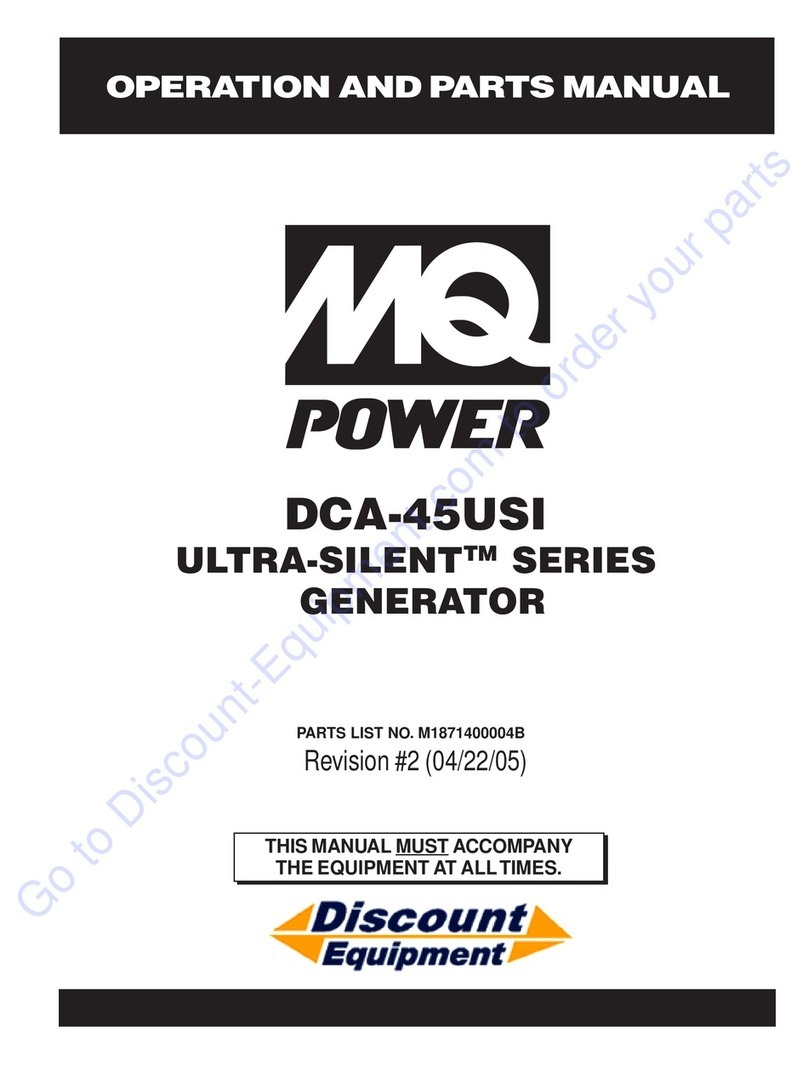
MQ Power
MQ Power ULTRA-SILENT DCA-45USI Series Operation and parts manual
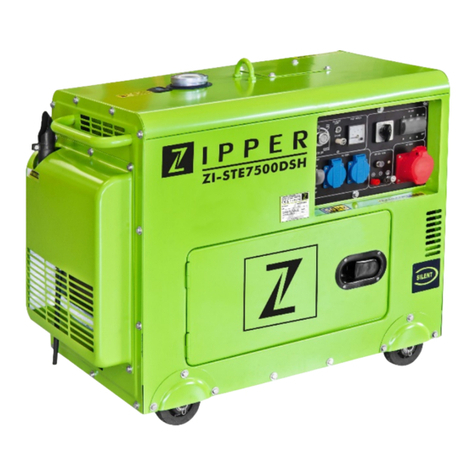
Z.I.P.P.ER MASCHINEN
Z.I.P.P.ER MASCHINEN ZI-STE7500DSH user manual

Caltest
Caltest LXI AFX Series manual
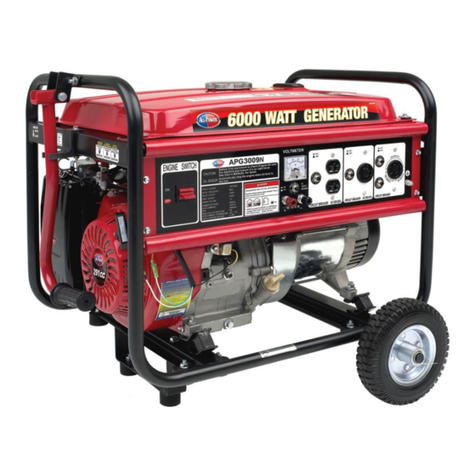
ALLPOWER
ALLPOWER APG3009N owner's manual
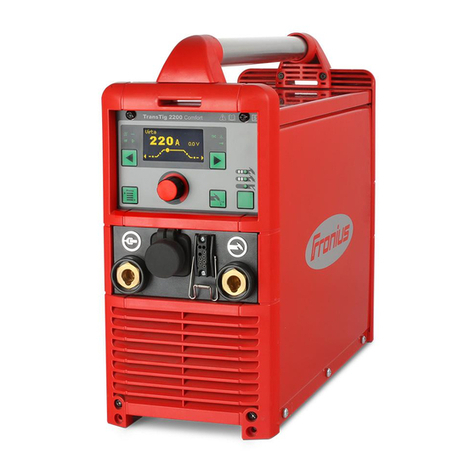
FRONIUS
FRONIUS TransTig 2200 Comfort operating instructions
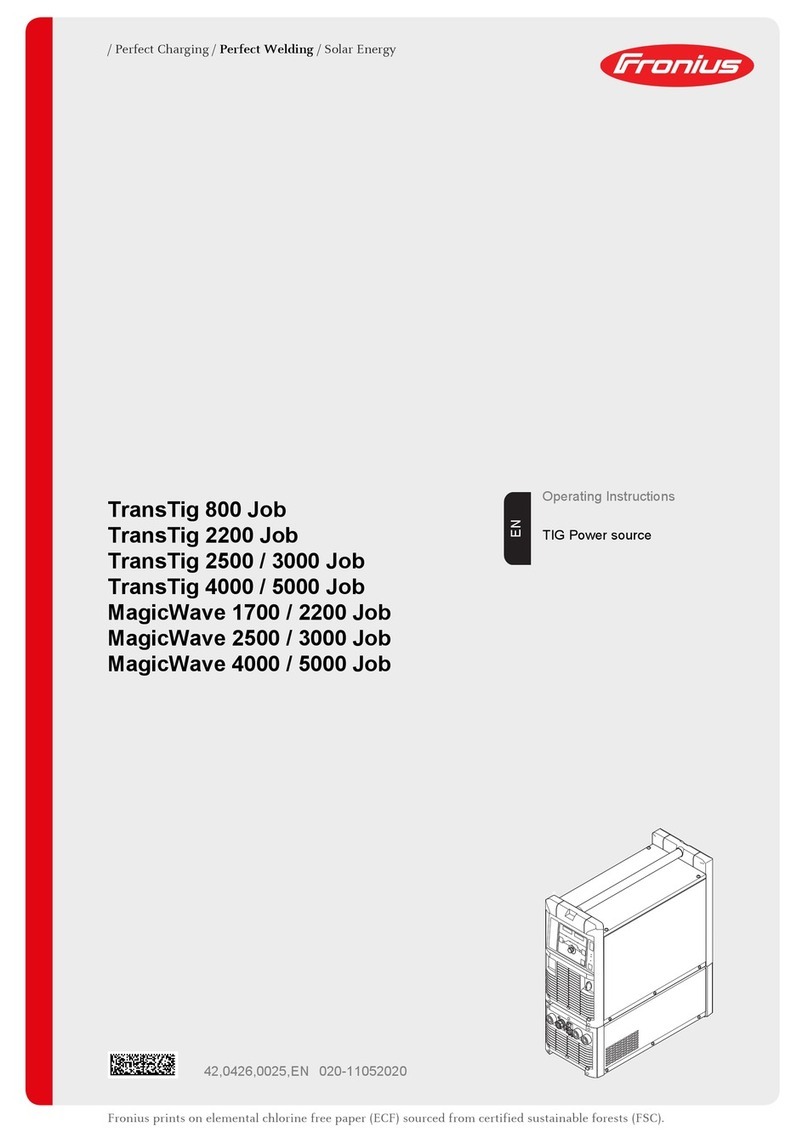
FRONIUS
FRONIUS TransTig 800 Job operating instructions



